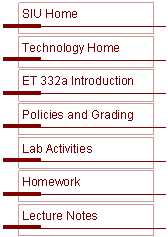

|
Department of Technology |
|
Course Leaning Outcomes |
|
At the end of this course, you will be able to: 1.) Explain how electromagnetism can transfer electric energy to mechanical energy. 2.) Use the basic principles of physics to describe simple linear and rotational motion. 3.) Determine the torque-speed relationships for typical mechanical loads. 4.) Explain the key parts of magnetic circuits and perform basic magnetic circuit calculations. 5.) List the sources of power loss in magnetic circuits. 6.) Explain how electromagnetic forces produce motor action. 7.) Explain how electromagnetic induction produces generator voltage. 8.) Explain how voltage is generated in elementary dc machines. 9.) Define commutation in dc machines and list factors that affect it. 10.) List the parts of a practical dc machine. 11.) Use the model of separately excited dc generator to perform electrical calculations. 12.) Determine the voltage regulation of a dc generator. 13.) Explain how torque is developed in a separately excited dc motor. 14.) Use the equivalent circuit model of the separately excited dc motor to perform calculations. 15.) Explain the operation of a shunt connected dc motor and use an equivalent circuit model to perform calculations. 16.) Determine the losses and efficiency of a dc motor. 17.) Interpret NEMA ratings. 18.) Read basic motor control ladder diagrams. 19.) Interpret starter motor/generator terminal markings. 20.) List dc motor starting methods. 21.) Compare and contrast the torque speed characteristics of separately excited, shunt, series, and compound connected dc motors. 22.) Calculate speed regulation of a dc motor. 23.) Calculate motor performance when magnetic circuits saturate. 24.) Explain how photocells convert light into electric current. 25.) Compute photocell voltage, current, and efficiency. 26.) Draw and perform calculations with a solar cell circuit model. 27.) Find the maximum power transfer of a solar cell. 28.) Analyze the economics of owning a solar panel. |
|
ET 332a Dc Motor, Generators and Energy Conversion Devices |
